Benefits of sole, and information on the different nutritional properties of an ideal white fish in healthy and healthy diets thanks to its qualities.

The sole is, along with hake, a fish most commonly consumed in many cuisines of the world, being a food of very good quality and taste soft, which combines almost perfectly with a number of various and diverse ingredients.
The sole belongs to the Soleidos family, and although its best season is between the months of March and April only, the truth is that it is possible – luckily – to find it practically throughout the year in the market.
We must take into account something fundamental, and that surely many people miss: in many fishmongers it is common to sell flat fish species that are called sole, but that – nevertheless – in reality they are not.
Nutritional properties of sole
Sole is a white fish (a group of fish that are also called lean fish), which means that its fat content is relatively low: 100 grams of sole provide only 1.5 grams of fat.
Therefore, as we will see in the section dedicated to the benefits of sole , we are faced with an ideal food in low-fat diets, useful for example for people who must lower their cholesterol and want to reduce their weight.
Although it does not provide many proteins, it does contain proteins of high biological value. In addition, among the vitamins we find in its meat, especially vitamins of the B group (such as vitamin B3 and B9 or folic acid), and minerals such as phosphorus, potassium, magnesium, iodine and iron stand out.
| Calories | 81 kcal | ||
| Protein | 16.5 g | ||
| Carbohydrates | 0.5 g | ||
| Total fat | 1.5 g | ||
| Vitamins | Minerals | ||
| Vitamin B3 | 5 mg | Iron | 0.7 mg |
| Vitamin B9 | 11 mcg | Match | 260 mg |
| Potassium | 230 mg | ||
| Magnesium | 28 mg | ||
| Iodine | 30 mg | ||
Sole benefits
On the one hand, we could highlight the very low caloric content of sole, a lean fish that hardly provides fat. Hence, its consumption is recommended in hypocaloric diets (low in calories), which pursue the objective of losing weight and losing weight. In this sense, we must always take into account the way of cooking or preparation chosen, especially when not increasing its caloric value and therefore the presence of fats.
It is an easily digestible food, so its consumption is recommended for people with digestive problems.
It is a fish rich in B vitamins, so that by providing folic acid it becomes an ideal food in the diet of future moms who are precisely pregnant. It also provides vitamin B3.
In relation to its mineral content, we can highlight phosphorus (which intervenes in the nervous system and muscular activity), iodine (essential for the proper functioning of the thyroid gland), potassium (participates in the functioning of muscular activity and nervous system) and iron (useful for the prevention of iron deficiency anemia).































